What is Better Uptime?
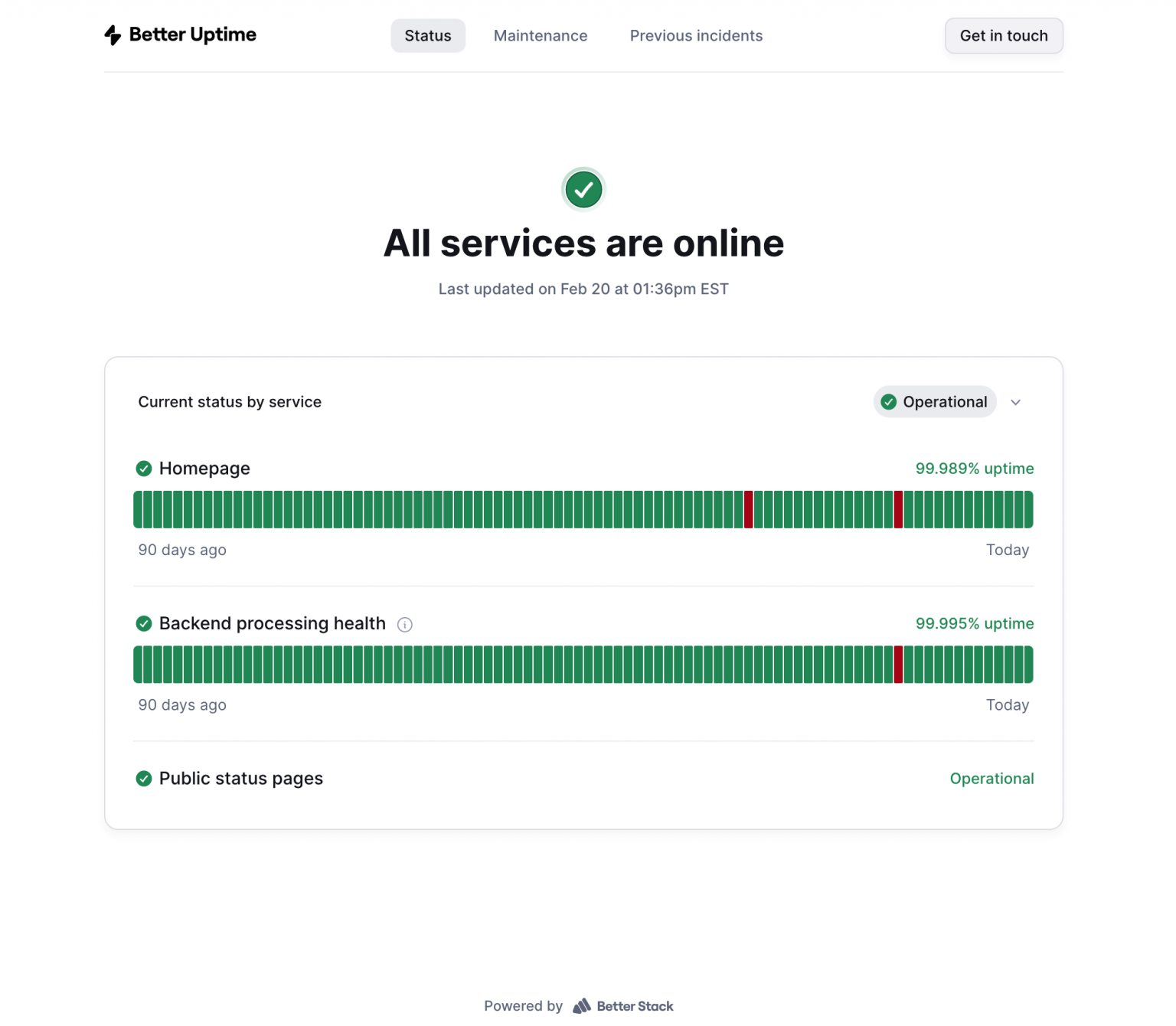
Better Uptime is a commonly used status page provider that’s also popular for monitoring uptime. However, unlike most other status page providers, Better Uptime combines incident management, uptime monitoring, and status pages into a single product (depending on your plan).
Better Uptime offers a free, fully-customizable status page. Paid plans also allow users to set up password-protected pages and e-mail and API status subscriptions.
Apart from the status page for your website or app, Better Uptime offers a range of features, including, but not limited to:
- An easy-to-navigate incident management system.
- Unlimited phone calls and SMS alerts on paid plans.
- Optional integration with Slack or Microsoft Teams.
- Straightforward alert management.
- Built-in synthetic monitoring.
Better Uptime is a good status page provider if you need incident monitoring software, too. Otherwise, here’s a list of status page providers that are the alternatives to Better Uptime.
Better Uptime Alternative #1 – StatusGator
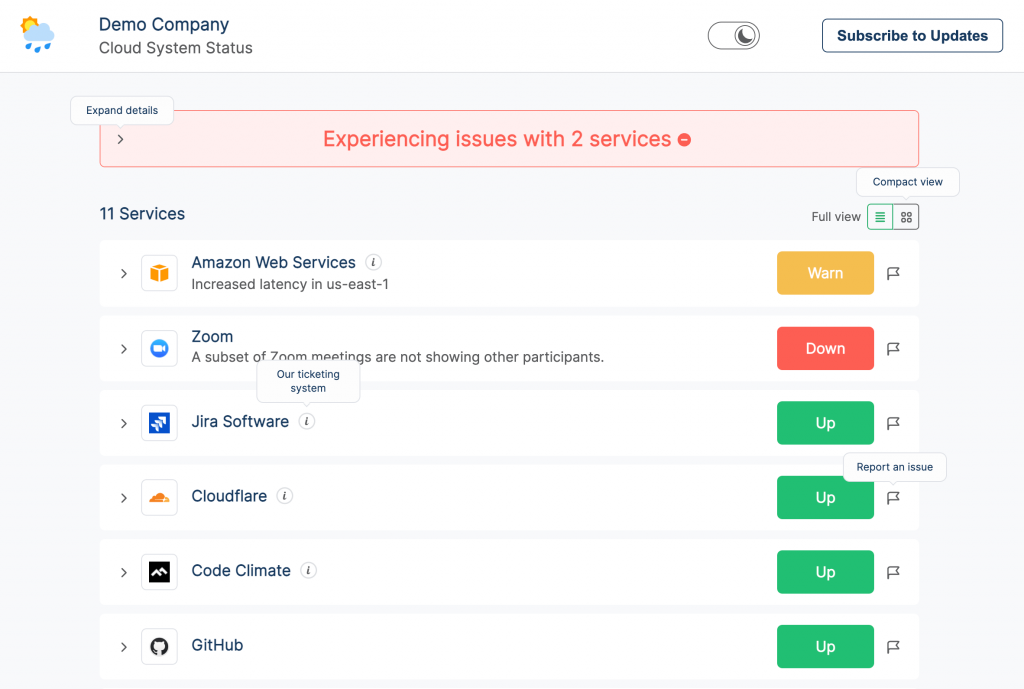
Before we jump into why StatusGator is our top pick – note that this is not a typical Better Uptime alternative. So, why are we looking at it?
Well, StatusGator provides a status page with all the essential features you would expect. However, it can offer more than your typical Better Uptime competitors and alternatives.
The critical difference is that StatusGator unifies the statuses of all your services into a single status page. Since all your status data is aggregated, you can directly monitor and display the status of all your cloud vendors (2,700 services), hosted applications, services, websites, and more.
This powerful combination makes it the ideal tool for internal team and IT status pages. Due to its unique aggregation feature, and all the status page features, StatusGator quickly makes the best alternative to Better Uptime.
StatusGator vs. Better Uptime
When comparing the two, the key standout is that StatusGator aggregates the statuses of 2,800+ cloud services (AWS, Atlassian, Cloudflare, etc.) or a website into a single status page.
Additionally, StatusGator has a direct monitoring feature that users can use to monitor internal tools, such as your website and other services with no status pages. Combined with the status page aggregation feature, StatusGator can offer a unique perspective on status monitoring which is easy to use and more advanced than traditional status page providers.
Better Uptime cannot provide this, meaning you’re getting more for your money with StatusGator.
StatusGator offers private status pages for your internal teams or limited audiences, but Better Uptime does not.
Benefits of StatusGator
- All status page features you need in one plan with unlimited notifications.
- Private and public status pages in a single plan.
- 2,700 cloud services statuses monitored
- Website monitoring built-in: no third-party tool is needed.
- Password protection
- 2FA and SSO
- Custom domain, logo, and favicon upload with branding removal
- Great pricing – Free plan and free trial with all plans.
Better Uptime Alternative #2 – UptimeRobot
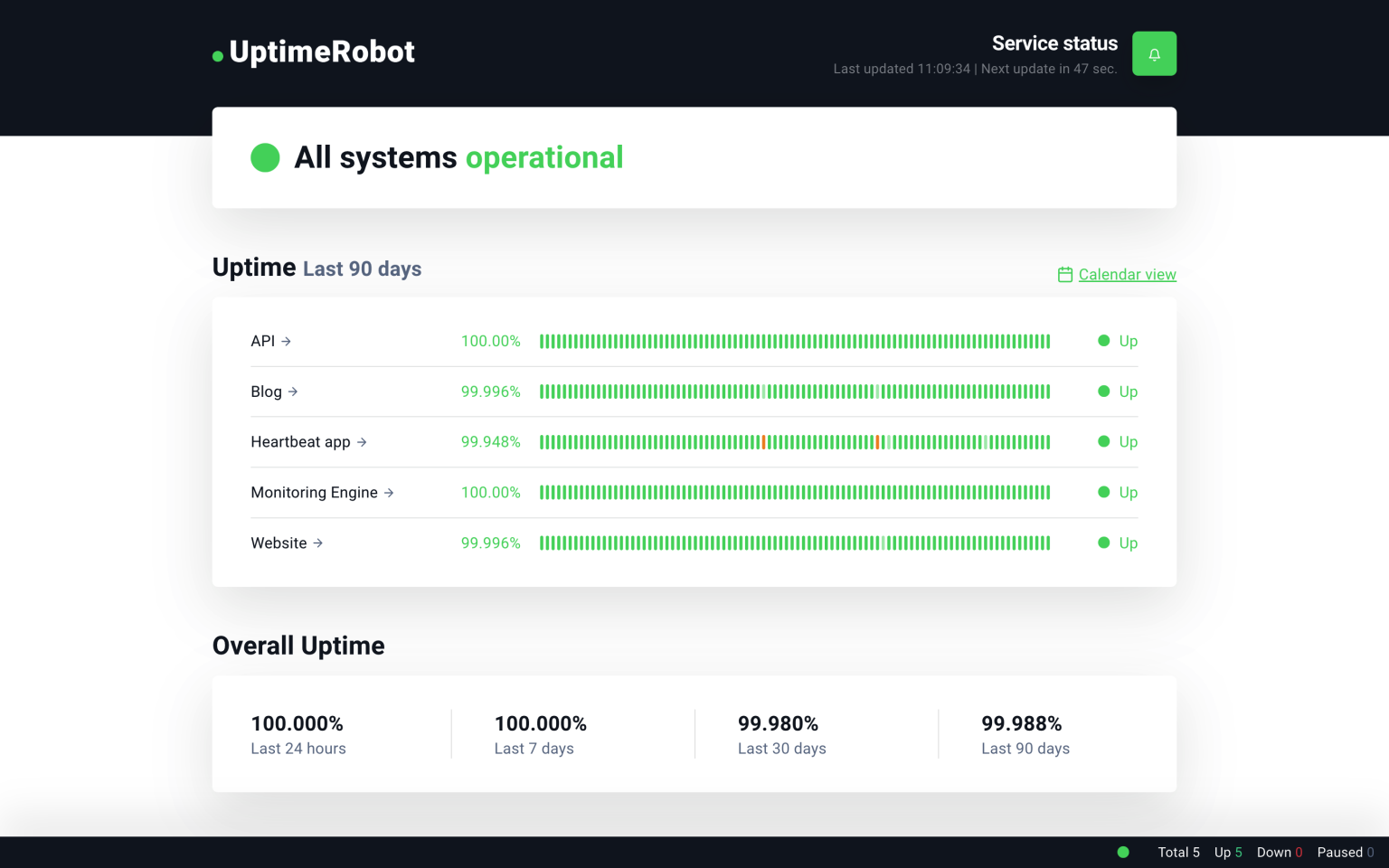
UptimeRobot is primarily an uptime monitoring service that monitors your website, ports, cron jobs, ping, SSL, and even keywords. A basic status page is available on their free plan. However, the features are limited.
Starting with $7 per month, users get three status pages. With the next-tier plan, for $29, users can change the look of their status page, and have a custom domain, private status page, and analytics.
UptimeRobot could be an option for you instead of Better Uptime if you want a cheaper status page and a decent uptime monitoring solution.
UptimeRobot vs. Better Uptime
Status pages are secondary in the services package provided by UptimeRobot, and uptime monitoring is their primary product.
Uptime Robot offers valuable features, but it might not be for you if a status page, as well as customization, is something you need and at a low cost. While only their paid plan offers a status page with features, UptimeRobot is the alternative we suggest most for uptime monitoring after Better Uptime, and it’s still worth considering its paid plan.
#3 Instatus as a Better Uptime Alternative
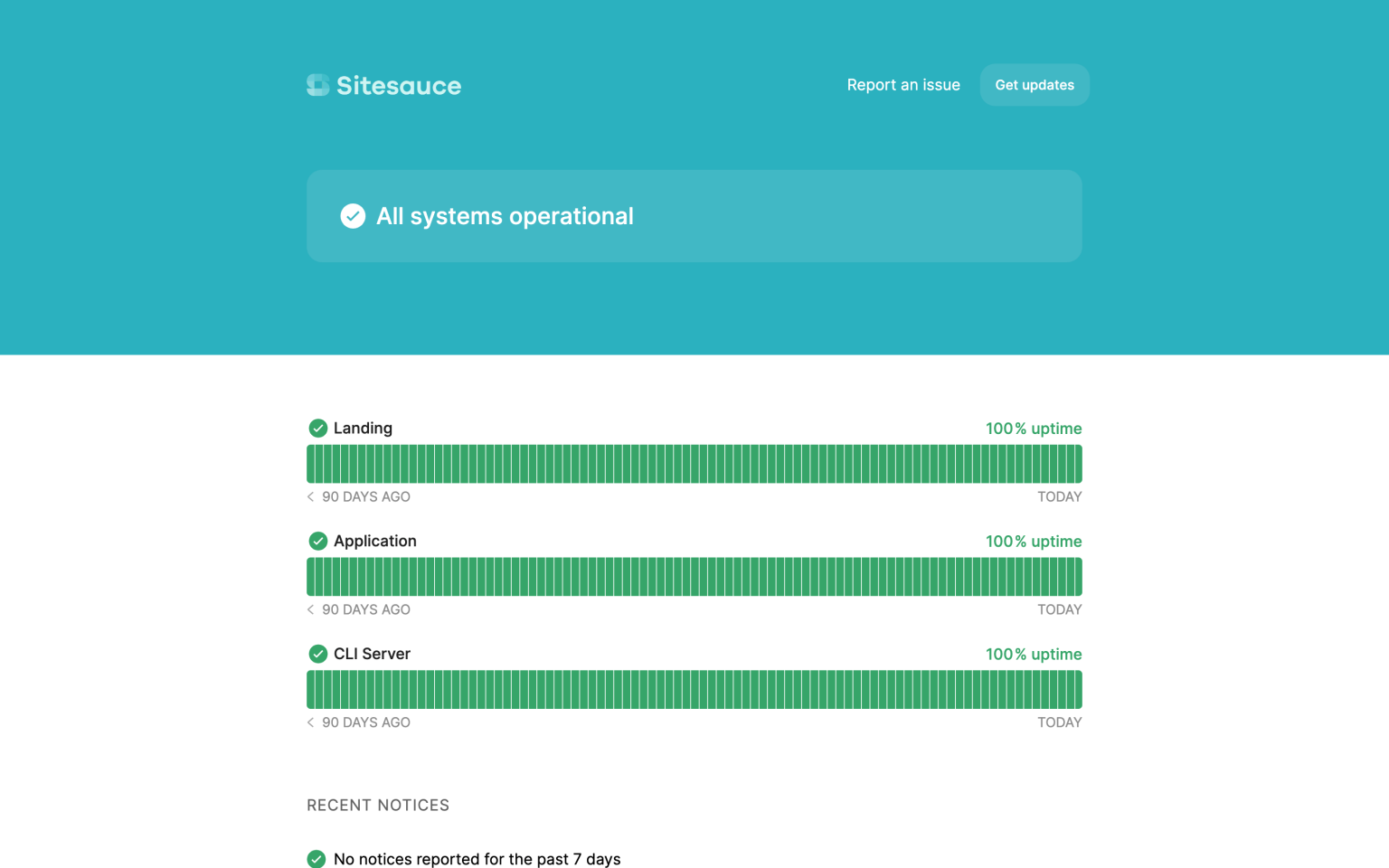
While Instatus is a more recent status page provider, it’s still a robust Better Uptime alternative. They offer a free status page with unlimited subscribers and teams. They also provide standard features (e-mail subscriptions, scheduled maintenance, incident templates, etc.) that you would expect from a provider. Additionally, they offer API integrations with incident management tools (e.g., PagerDuty).
Instatus vs. Better Uptime
Overall, Instatus is a very well-designed tool and a strong status page competitor to Better Uptime. It focuses on distinguishing itself with reasonable pricing for smaller teams and users. No limit on the number of subscribers is an example of how Instatus could be a better status page provider than Better Uptime.
However, using your domain comes at $20 per month, and a private status page also costs $50 per month. Another $100 monthly is the cost of limiting access to a specific audience. So, looking at Better Uptime vs. Instatus as a status page provider, the difference is in the rates and your needs.
Benefits of Instatus
- Allows users to add a status widget on a website
- Price does not depend on the number of subscribers to a status page – subscriptions are unlimited
- Supports different languages
- API and Integration with incident management tools like PagerDuty
#4 Status.io as a Better Uptime Alternative
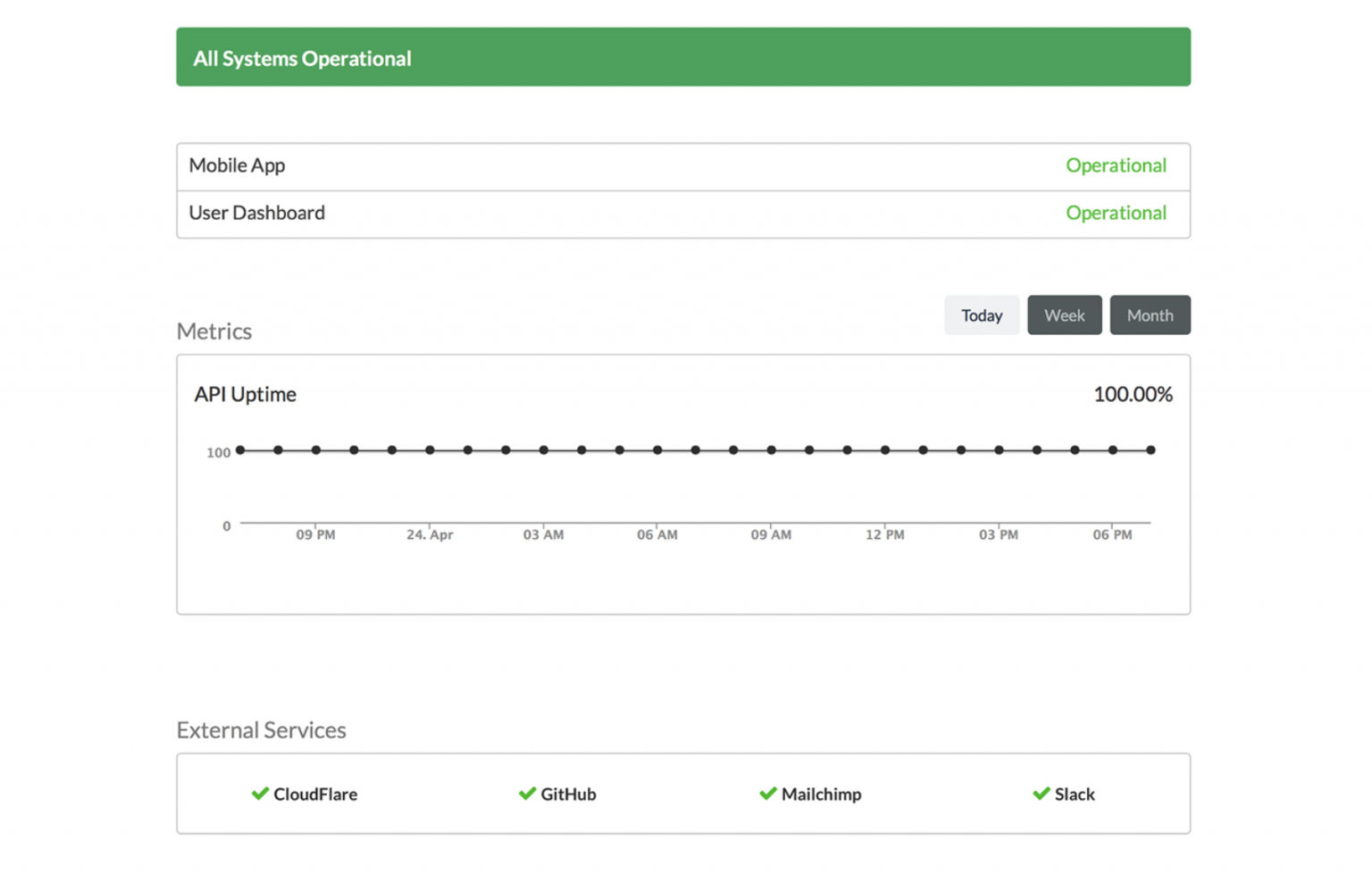
Status.io is a commonly used platform to host system status pages. It includes features such as customized incident tracking, subscriber notifications, and much more.
One key thing to note about Status.io is that it focuses on the transparency and reliability of its services as a status page provider. The systems that host the Status.io software are redundantly distributed across multiple regions for efficient offsite hosting.
In addition to this, Status.io also makes it easy to create a beautiful status page for your app, website, or online services and products. Status.io, similarly to its competitor BetterUptime, offers a great feature of personalizing a status page in line with the website’s brand or design.
Another benefit of Status.io as an alternative to BetterUptime is a testing status page to practice.
As for technical details, Status.io includes complete control for complex distributed systems and multi-tenant infrastructure. Leading tools and platforms that Status.io can integrate with:
- Librato
- New Relic
- OpsGenie
- PagerDuty
- Pingdom
- Pingometer
- Uptime Robot
Other leading functions that Status.io can offer are as follows:
- Performance monitoring
- A variety of metrics to display
- Subscriber notifications
- Sharing capabilities with multiple tools
- Link monitoring tools for status automation
- Twitter broadcasts

Status.io vs. Better Uptime
Status.io focuses significantly on personalization and transparency, vital components of an effective status page. Status.io includes a private status page and third-party status display in their plans. Despite this, it could be beneficial for Status.io to clarify how many third parties are available for status monitoring.
With Status.io, you will pay more for the status page than with BetterUptime. But if you need a more reliable service, then Status.io works with its distribution system and is a valid BetterUptime alternative as a status page system.
Benefits of Status.io
- Automatic notifications for component status triggered by updates
- Redundantly distributed system across multiple regions
- Enablement of the complete control for complex distributed systems and multi-tenant infrastructure
- Metric display via Custom Metric API or external data source
- SSO and access control based on IP
#5 StatusPage.io as a Better Uptime Alternative
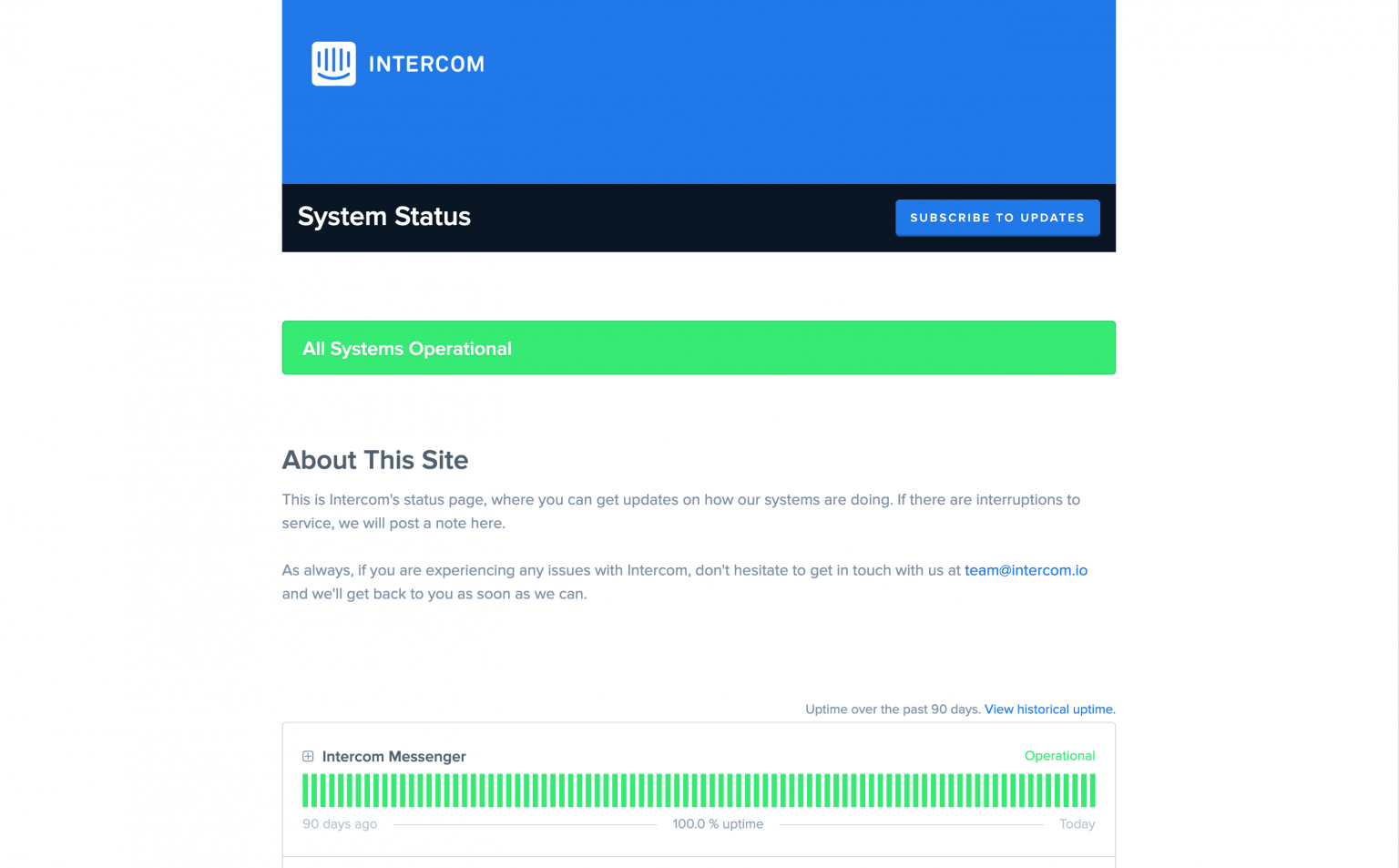
Statuspage.io is a communication tool but not a monitoring tool.
Statuspage.io is widely used for public and private status page services but these are charged separately. There is also stand-alone pricing for audience-specific pages. Depending on your needs and budget, it could be your choice.
Atlassian purchased Statuspage.io in 2016, and significantly invested in expanding the status page service, so it’s a robust Better Uptime alternative today.
A key thing to note is that Statuspage.io doesn’t ping your servers or endpoints to check their status, but it does integrate with a few monitoring and alerting tools to automate status page updates.
Benefits of Statuspage.io
- 30-second interval checks
- Displaying the status of stand-alone components
- Atlassian product
- Has a free plan
- Password protection
- CSS on paid plans
#6 Upptime as a Better Uptime Alternative
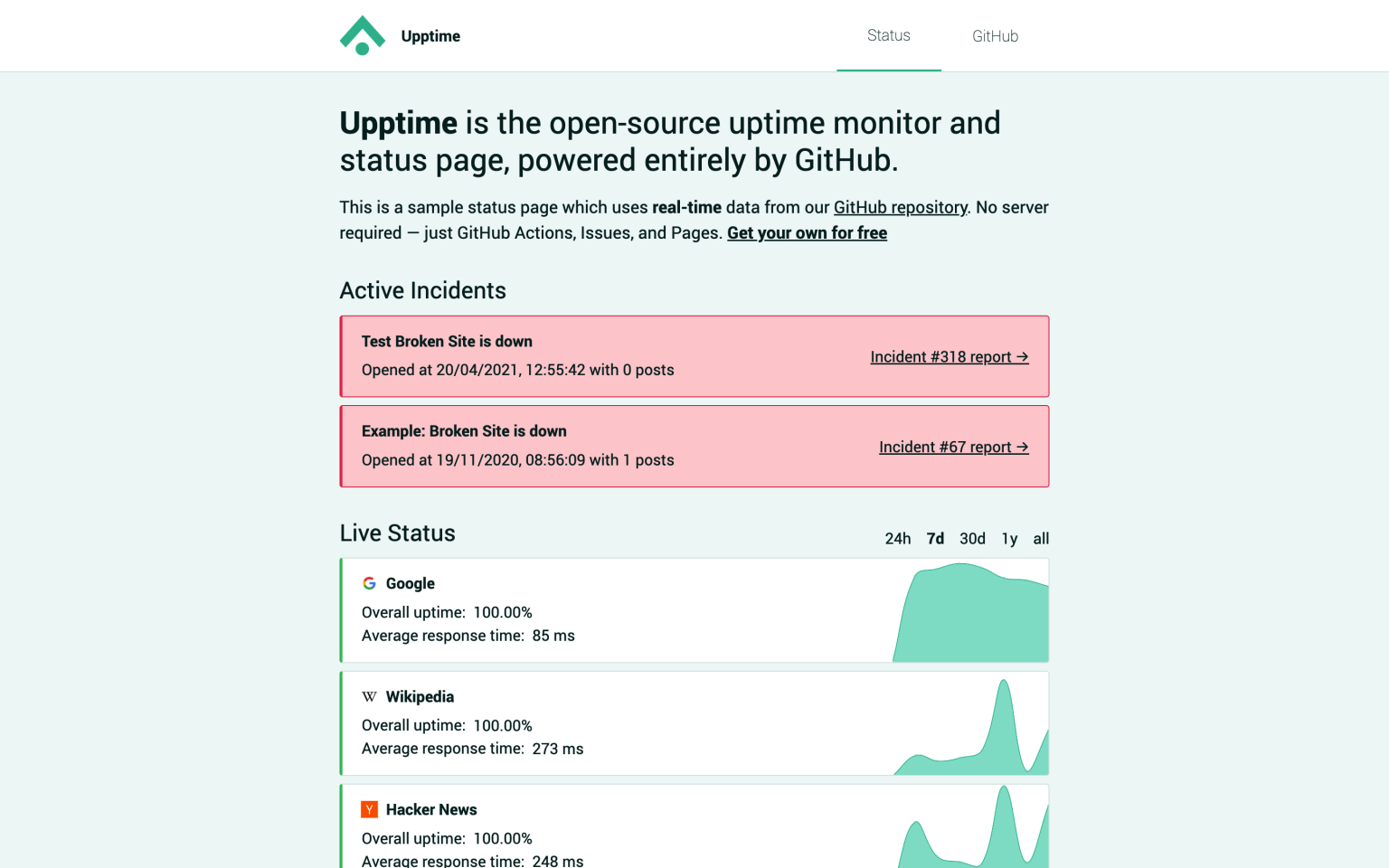
In short, Upptime is an open-source uptime monitor and status page. Uptime status page service uses GitHub Actions, Issues, and Pages – meaning GitHub entirely powers it!
Upptime allows users to schedule workflows to run automatically in pre-set time intervals via GitHub Actions. The shortest interval possible to set is 5 minutes.
Another exciting feature is that Upptime records graphical data of your website’s response time once a day. It also enables users to share their long-term statistics. If that’s not enough to consider Upptime as a BetterUptime alternative, let’s remind you that Upptime is a free status page software. It also offers customization to tailor the status page to your brand. As you already know many BetterUptime competitors charge additionally for customization.
Benefits of Upptime
- No server is needed as Upptime runs the GitHub repository
- Offers complete customization
- Supports setting up numerous features
- Status updates (5-minute intervals) using GitHub Actions
#7 Cachet as an Open Source Better Uptime Alternative
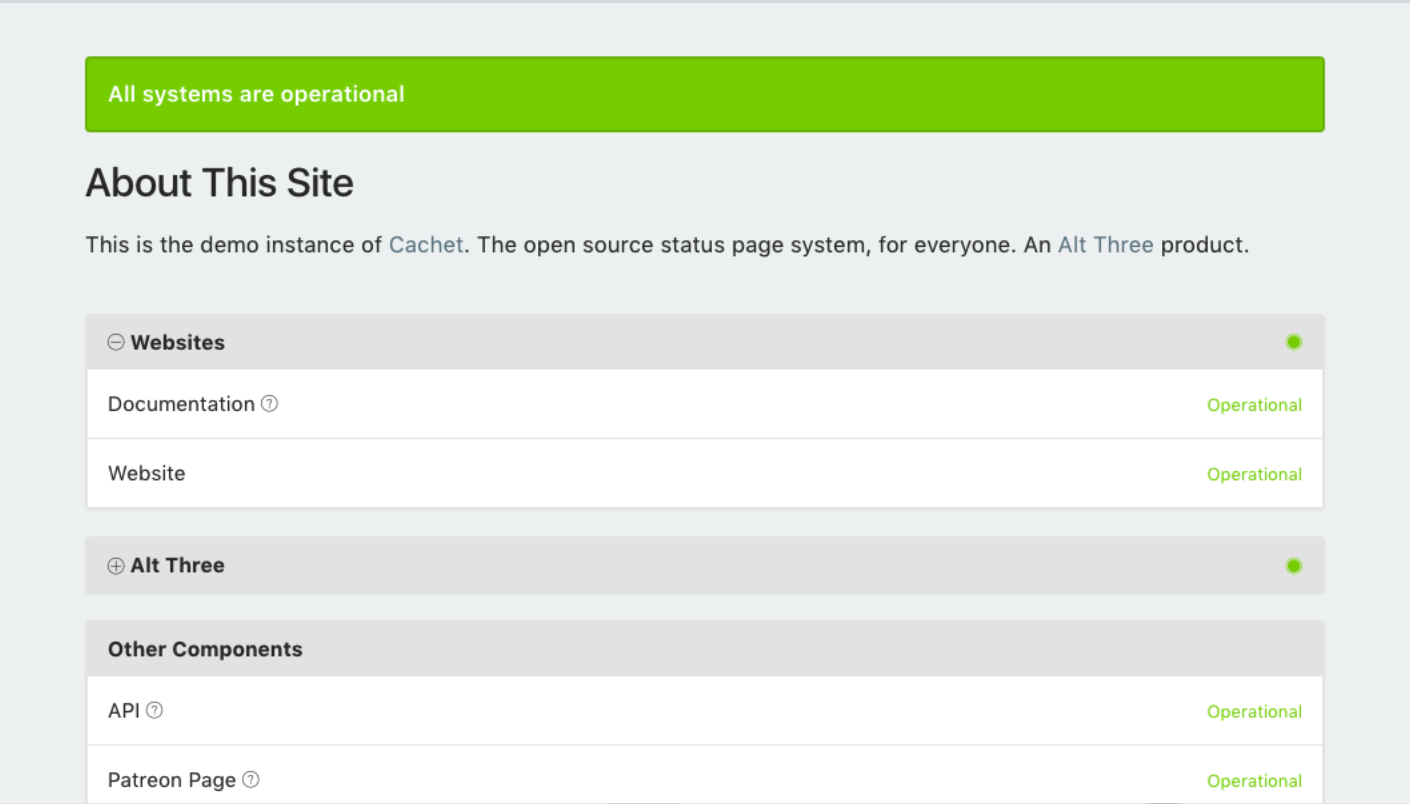
The first thing you might notice with Cachet is that it is an open-source status page system made using Bootstrap 3.
Overall, we think Cachet is a strong Better Uptime alternative. Cachet offers essential status monitoring via a great chart dashboard. Cachet users can easily set up any metrics, be it uptime, error, or response time with API. Cachet offers two-factor authentication with the Google Authenticator app.
There are, however, prerequisites to installing Cachet – something to keep in mind.
Cachet vs. Better Uptime
Overall, Cachet is free and customizable, and it can be a choice for users who want open-source status page software. It has an excellent Slack community, and Cachet is dedicated to being a robust Better Uptime alternative.
Benefits of Cachet
- It is free
- Displays numerous metrics on the dashboard
- Has 2FA (Two-factor authentication)
- Supports different languages
- Has a Slack community.
Why is communicating updates on a Status Page beneficial?
There are many reasons why being transparent with status updates is beneficial:
- Quick access to historical data on uptime, downtime, and outage frequency to be transparent with your customers.
- Prevent customer service from being overloaded with support tickets.
- Good UX for users to know the status of your service.
There are endless reasons why a status page is beneficial for customer relationships and service transparency. However, it comes down to two main benefits – lower support overload and higher customer trust. Trust is gained through transparency, but how can a status page lower support costs?
Lower support costs result from users checking your status page and reading your system announcements. As a result, customer service isn’t swamped with support tickets, and users are notified more quickly of the issue.
How Can I Get a Reliable Status Page?
The whole point of a status page is to be transparent with your status history – so making a reliable one is critical. Here are some helpful tips
- Start by having a clear URL that users can search for or remember. Having a separate domain is a good idea so the status page is available when your website is down too. It’s a common practice.
- Another trick is to add a link to your status page on your website. There’s no need for it to be a key feature – just a subtle yet clear link in the footer will do.
- If you want to go all in, add a link on your support page to get users’ attention before they submit tickets – this can save time and money!
- A subscription option for your status page is also beneficial, especially during downtime. A status page subscription option allows everyone to receive a notification, typically via e-mail, whenever your website goes down.
Once a status page is live, you can build trust with users by communicating issues before they become a problem. By having a reliable status page, users will know that if something goes wrong, they can trust your status page to provide accurate, updated incident details.
Types of Tools: Monitoring vs. Communication vs. Aggregation
Before we compare Better Uptime alternatives, here are some terms we need to consider with examples:
- Communication: Messages are communicated to inform customers of incidents and are integrated with other monitoring and alerting tools. Statuspage.io is an example.
- Monitoring: Pingdom is a strong example – as Pingdom allows you to set up intervals at which your servers are getting pinged, and the status of these pings is reflected on your customer-facing page.
- Aggregator: StatusGator is a status page aggregator – StatusGator is a multitool that aggregates and displays multiple status pages for an internal team.
Side-by-side Comparison of Status Page Providers
| Criteria | StatusGator | Statuspage | Better Uptime | Cachet | Instatus | Status.io | UptimeRobot | Upptime |
|---|---|---|---|---|---|---|---|---|
| Primary category | communication, monitoring, aggregation | communication | monitoring | communication | communication | communication | monitoring | monitoring |
| Key differences | ||||||||
| Private status page | ✅ On all plans | From $79/month | From $200/month | ❓ | For $50/month | For $349/month | For $348/month | ❓ |
| Components display | ✅ | ✅ | ❓ | ✅ | ✅ | ✅ | ❓ | ❓ |
| Website monitoring | ✅ | ❌ | ✅ | ❌ | ❌ | ❌ | ✅ | ❌ |
| Monitoring - third-party service statuses | 2,800+ | 200 | ❌ | ❌ | 168 | 170 | ❌ | ❌ |
| Trial | ✅ | ❌ | ❌ | ❌ | Only on private pages | ❌ | ❌ | ❌ |
| Cost per month | Starts at $72 | Starts at $29 | Starts at $30 | Free | Starts at $20 | Starts at $79 | Starts at $7 | Free |
| Status page features | ||||||||
| Hosted | ✅ | ✅ | ✅ | self-hosted | ✅ | ✅ | ✅ | ✅ |
| Favicon | ✅ | ✅ | ❓ | ✅ | ✅ | ✅ | ❓ | ✅ |
| CSS | ✅ | On paid plans | ✅ | ✅ | ✅ | ✅ | ❓ | ✅ |
| Branding removal | ✅ | ❓ | ❓ | ❓ | ❓ | On Standard plan and higher | On PRO plan and higher | ❓ |
| Components display | ✅ | ✅ | ❓ | ✅ | ✅ | ✅ | ❓ | ❓ |
| Subscribers to status pages | Unlimited | Limited | Limited. Available on higher plans only | Unavailable | Unlimited | Limited. Quantity depends on the plan | Limited. Available on higher plans only | Unavailable |
| Notifications | Email, SMS, Slack, MS Teams, Discord | Slack email, Webhook | Voice call, SMS, Mobile pushSlack, Microsoft Teams | SMS, Discord Slack, Twitter, Micrisoft teams, email | Twitter, SMS, voice call, Email, Slack, Discord Telegram | Email, SMS, voice call, Slack, Zapier, Twitter | Slack, Telegram, Webhooks |
|
| Password protection | ✅ | On Starter plan and higher | On Business plan and higher | ✅ | On Private PRO plan and higher | Authentication via SSO, SAML Identity Providers, IP Access control | ❓ | ❓ |
| Monitoring | ||||||||
| Ping interval | 5 min | 30 sec | 3 min or 30 sec on Freelancer plan and higher | ❓ | ❓ | ❓ | 5 min or 1 min on PRO plan | 5 min |
| General | ||||||||
| Documentation | Great | Good | Good | Great | OK | OK | OK | Good |
| Support | Contact form, email, chat | Contact form | Email, chat, phone | Email, Help with installation $249 | Chat, email | Chat | GitHub | |
| Account security | 2FA, SSO | 2FA, G Suite and SAML single sign-on | 2FA, GDPR, SSO on Enterprise plan | 2FA | SSO / SAML on Business plan | 2FA with Yubikey,Custom TLS / SSL Certificate, IP filtering, | 2FA | ❓ |

Summary
We reviewed the seven best alternatives to Better Uptime so that you can decide which one works best for you.
Each has its own attributes, similar to Statuspage and not, all of which are strong competitors and alternatives to BetterUptime. Here is a quick breakdown:
- If you need to monitor your cloud dependencies and communicate the status of these dependencies on your status page – choose StatusGator.
- You could check out UptimeRobot for status pages if you are looking for a website, port, SSL, cron job, and keyword monitoring solution.
- Instatus is a communication tool with a simple pricing system that does not depend on scaling business. It can work well if you manually create incidents and do not need to monitor anything.
- Status.io could work well for users who have an account with Librato, New Relic, Pingdom, or a custom monitoring tool looking to automate communicating status to their users.
- StatusPage.io offers a free status page, a custom domain, and 30-second interval checks – if you’re looking for good value.
- For users who are interested in a self-hosted status page – try Cachet. Users point out the ability to set up any metric and robust documentation to cover any questions.
If you are looking for a monitoring solution that also offers status pages and is open-source, then see if Upptime fits your other criteria.
FAQ on Better Uptime Alternative
Q: What is the best alternative to Better Uptime?
A: StatusGator is an alternative to the Better Uptime status page. It gives your team a unified status page showing the status of all of your cloud vendors, hosted applications, services, websites, and more. Regarding the status page, StatusGator offers more features than Better Uptime, mainly because the status page is a primary product of StatusGator. At the same time, it is secondary for Better Uptime, a monitoring software in the first place.
Q: Which status page software is better?
A: Due to the unique service, StatusGator is the best status page software. You can set up a single status page with the statuses of separate components of your service and all the statuses of your cloud dependencies. The status page can be either public or private for affordable prices. It’s easy to use and can go a long way toward transparency between you and your customers. It also has internal monitoring tools for your services, third-party dependencies, etc. Currently, StatusGator monitors and normalizes status data from 2,800+ cloud services.
Q: What is the difference between open-source and paid status page software?
A: There are free, open-source status page solutions that require hosting and might have other prerequisites that will cost you money to set up. As for the paid software, it hosts a status page for you.
A status page is usually set up in minutes with a service like StatusGator. Moreover, you can also add the statuses of your cloud dependencies. It makes StatusGater a great alternative to Better Uptime and open-source status page solutions, which require time to set up.
Q: Who are the main competitors of Better Uptime in terms of status page software?
A: Arguably, the main competition to Better Uptime is defined by the features a potential user seeks. For example, StatusGator offers more than a public, private, or password-protected status page, and the statuses of cloud services can be added to a user’s status page too. Also, StatusGator is cheaper.
Q: What are the benefits of having a status page?
A: The key benefit of having a status page is that it goes a long way toward transparency between you and your customers. With StatusGator, you can also have a bird’s view into your cloud services. So not only are your users aware of the status of your services, but you also get to display the statuses of your dependencies.



